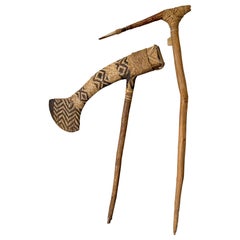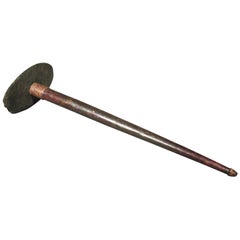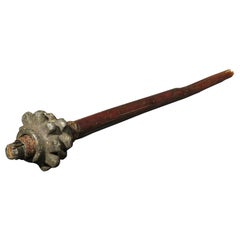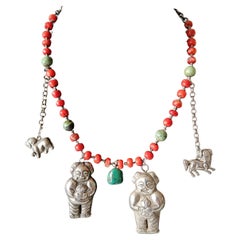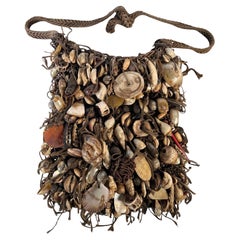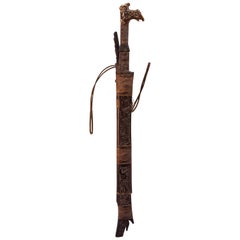Rattan Arms, Armor and Weapons
to
1
3
3
2
1
9,429
285
163
125
79
3
3
3
3
3
3
Material: Rattan
Two Ceremonial Weapon from Highlands of Papua New Guinea Provenance
Located in Atlanta, GA
Two Oceanic ceremonial weapons from PNG highlands circa 20th century. It consists of two pieces. The first is an ax with a wood shaft and a flat elongated he...
Category
Mid-20th Century Papua New Guinean Tribal Rattan Arms, Armor and Weapons
Materials
Rattan, Wood
A Rare Papua New Guinea Kukukuku War Club, Eastern Highlands - Morobe Province
Located in Ottawa, Ontario
This rare antique Kukukuku (pronounced "cookah-cookah") war club originates from the Morobe Province, which is a very remote area located within the Eastern Highlands of Papua New Gu...
Category
Early 20th Century Papua New Guinean Tribal Rattan Arms, Armor and Weapons
Materials
Stone
A Rare Papua New Guinea Kukukuku 'Pineapple' Stone War Club, Eastern Highlands
Located in Ottawa, Ontario
This rare antique Kukukuku (pronounced "cookah-cookah") war club is from the remote Morobe Province located within the Eastern Highlands of Papua New Guinea.
The head is carved from...
Category
Early 20th Century Papua New Guinean Tribal Rattan Arms, Armor and Weapons
Materials
Stone
Related Items
Rare Antique Qing Dynasty Chinese Ethnic Minority silver Coral necklace
Located in London, GB
A beautiful rare Antique Qing Dynasty Chinese Ethnic Minority silver Coral turquoise necklace from Yunnan.
A superb chain necklace with added Taoist charms with turquoise and fine r...
Category
Mid-19th Century Chinese Antique Rattan Arms, Armor and Weapons
Materials
Silver
$912
H 20.48 in W 2.37 in D 0.4 in
Antique Tribal Shaman’s Bilum Bag From Papua New Guinea Circa 1900
Located in Dallas, TX
This authentic tribal shaman’s medical bag, known as a Bilum bag, originates from Papua New Guinea and dates back to circa 1900. Traditionally used by shamans for carrying medicinal ...
Category
Early 1900s Papua New Guinean Antique Rattan Arms, Armor and Weapons
Materials
Shell, Rope
Tibetan Coral Necklace with Silver Painted Wooden Beads c. 1900
Located in Jimbaran, Bali
A wonderful example of a Tibetan Coral Bead mala / neckpiece with a stunning mix of orange & red colours that have aged beautifully over the decades. Tib...
Category
Early 20th Century Tibetan Tribal Rattan Arms, Armor and Weapons
Materials
Coral, Silver
Fine Hardwood Drum
Located in Bridgeport, CT
An authentic Tribal drum in all original condition. The Hardwood body of the Drum features fine Graining and has substantial weight. The very tight constru...
Category
Mid-20th Century Unknown Tribal Rattan Arms, Armor and Weapons
Materials
Leather, Hardwood
Vintage Papua New Guinea Funeral Mask c.1950-1960
Located in San Francisco, CA
ABOUT
A vintage wooden mask constructed with wild boar tusks, shells, feathers and twin. Used in funeral ceremonials on the island of New Ireland, New Guinea.
Category
Mid-20th Century Papua New Guinean Tribal Rattan Arms, Armor and Weapons
Materials
Bone, Shell, Twine, Wood
Antique Ethnic Artifact Sepik River Cassowary Bone from Papua New Guinea
Located in Moreno Valley, CA
Antique Ethnic Artifact Sepik River Cassowary Bone from Papua New Guinea
For many groups in Papua New Guinea, bone was an important medium for making tools of all types. This artifact is made from leg bone of a cassowary, a large, flightless, and extremely dangerous, bird.
Cassowaries also play an important role in the mythology of groups in the Sepik River area.
Though no longer used these bone artifacts are still used ceremonially. They often play important roles in male initiation and other rituals. They are also worn as personal adornment by tucking them into a band of braided fibers worn around the upper arm.
Antique Ethnic Bone Cassowary Artifact with minimal carving and incised design confined to the joint end.
A small hole has been drilled through from both sides of the top and presumably for the threading of a cord.
The bone has been partially divided near the top and to form two prongs that project down the back of the dagger possibly allowing the user to wear is tuck into a waist band or belt.
Origin Papua New Guinea Maprik Dist Area
From the Art Collection of Marian and John Scott, acquired in 1962.
Similar items are in display in the Timothy S. Y. Lam Museum of Anthropology.
Purchased from the amazing private collection of Mark Lissauer who spent his life collecting niche ethnographic pieces.
About Mark Lissauer:
Mark Lissauer spent forty years travelling abroad for months at a time collecting ethnographic artefacts primarily from New Guinea and the islands of the West Pacific, and from Asia and Himalayan countries. Fluent in five languages and having in the course of business travelled to more than forty countries, Mark is well-known to museums and art-collectors around the world for his long career and his interesting and diverse collection of rare ethnographic material.
Mark knows the origin and symbolism of each piece. Through extensive research and more than ninety trips around the globe, Mark familiarised himself with the traditions of the various cultures he visited in order to understand the meaning of each object to its region and tribe. His home has a specialist library and several rooms are filled with tribal carvings, textiles and ethnographica.
He acquired his first tribal piece in 1948 during a business trip to Milne Bay, New Guinea, and has since documented the acquisition of some 35,000 items. Several thousands of these have been sold to important private collections and museums worldwide, including the Rockefeller Museum, the British Museum and the Musée National des Arts d’Afrique et d’Océanie, now incorporated into the Louvre Museum.
Estimator certificate of authenticity by Wayne Heathcote Tribal Art Dealer and Expert.
Heathcote has a flash gallery in Brussels, where much of the tribal art business is centred, and is an expert at Sotheby's tribal art sale...
Category
Early 20th Century Folk Art Rattan Arms, Armor and Weapons
Materials
Bone
$650
H 1.25 in W 7.5 in D 1.5 in
Large Papua New Guinea Sepik River Mask Strong Face
Located in Point Richmond, CA
Large dark reddish brown carved wood mask with underlying traces of red pigment, from New Guinea Sepik River Area. Strong downward looking expression, carved fringe edges. Signs of...
Category
Mid-20th Century Papua New Guinean Tribal Rattan Arms, Armor and Weapons
Materials
Wood
$1,400 Sale Price
20% Off
H 26 in W 6.5 in D 4.5 in
Pair of Moroccan Berber Ethnic Silver Bracelets
Located in Moreno Valley, CA
Pair of Moroccan Berber Tribal bracelets.
Moroccan Tribal bracelets from the High Atlas of Morocco.
Handcrafted by Berber women using Moroccan silver nickel.
The ethnic Nomadic and Bedouin jewelry...
Category
20th Century Moroccan Tribal Rattan Arms, Armor and Weapons
Materials
Metal, Silver
Nias 'Kalabubu' Coconut & Brass Headhunter Necklace
Located in Jimbaran, Bali
This 'Kalabubu' necklace, also known as the 'head-hunter' necklace made out of coconut and brass is the most important ornament for the men of Southern Nias Island, North Sumatra...
Category
Early 20th Century Indonesian Tribal Rattan Arms, Armor and Weapons
Materials
Brass
African Fulani Currency Bracelet, c. 1900
Located in Chicago, IL
Characterized by its open shape capped with geometric ends, this bracelet is but one form of the many types of body adornments favored the Fulani people of West Africa. The thick des...
Category
Early 20th Century Nigerien Tribal Rattan Arms, Armor and Weapons
Materials
Brass
Antique Akha Hill Tribe Silver Cuff Bracelet, Golden Triangle
Located in Jimbaran, Bali
A large Akha Tribe woven silver bracelet with spiral design. This Tribal bracelet encompasses tradition Hill tribe silversmithing techniques with each silve...
Category
Early 20th Century Thai Tribal Rattan Arms, Armor and Weapons
Materials
Silver
African Bug Bead Necklace, Old Hand-Cast Metal Beads
Located in Point Richmond, CA
Fulani, Nigeria
Hand-cast brass beads on a hand-woven cord
19th century
Measures: 17 in. / 43 cm
8 oz. / 227 g.
Category
19th Century Nigerian Tribal Antique Rattan Arms, Armor and Weapons
Materials
Bronze
Previously Available Items
Tribal Mandau Sword with Scabbard from the Dayak of Borneo, Early 20th Century
Located in Point Richmond, CA
Tribal Mandau sword with Scabbard from the Dayak of Borneo, early 20th century.
Offered by Bruce Hughes.
Called Mandau or Parang Ilang, these swords were traditionally the most prize...
Category
Early 20th Century Indonesian Tribal Rattan Arms, Armor and Weapons
Materials
Steel
H 32 in W 2.75 in D 8 in
